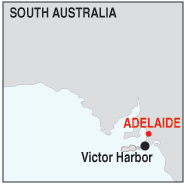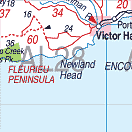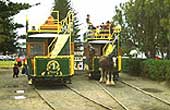|
Victor Harbor is located on Encounter Bay, on
the south-eastern side of the Fleurieu Peninsula, 85 km. south of Adelaide and
is a popular overnight stop for people exploring the many attractions of the
peninsula. When colonists arrived in 1836, Captain William Light was assigned the task of selecting a site for a capital city near a suitable port. Many, including the first governor, Governor Hindmarsh, believed that the Murray Mouth would become an important region to service the interior of Australia, just as New Orleans functioned with the Mississippi trade of North America. Their assertion that the capital be located in this region was strenghtened in 1837 when an American commanding the Royal Navy Brig, 'Victor', anchored safely near Granite Island, gave glowing reports of the region, and named his anchorage Victor Harbor. William Light disagreed with the report, believing Encounter Bay to not be safe all year round and that not sufficient agricultural land was in close proximity to sustain and develop a new settlement. He had the authority to prevail, and Victor Harbor remained a whaling station, isolated from the main settlement of Adelaide by inhospitable bushland and rugged ferrain. The whalers remained, an unruly mob that had decimated the aboriginal population with diseases, and prone to give refuge to fugitives from justice. In 1839, Governor Hindmarsh established a police force in the area to contain their extravagances, and as a secondary function, to conduct a mail service with Adelaide. Attempts were made to extend the Adelaide road to Willunga, to more adequately supply the region. Chaos resulted. The bullockies often ignored the official Government roads to facilitate themselves, and settlers ignored the unofficial 'roads' by planting crops and pasture along them. Despite the restricted access, the hills around Victor Harbor became dotted with settlers, grazing sheep to secure an income while clearing the land for wheat. By 1850, there were about 500 people in the area, and in 1854, the Lilliputian jetty was constructed at the eastern end of The Bluff to improve cargo handling of stores from Port Adelaide. In 1860, a rail link with Adelaide was commenced and in 1864, the Victor Harbor jetty and tramway from Goolwa at the Murray Mouth, was opened. The town was to become a major port. The jetty was extended to Granite Island in 1872, and the breakwater off the island was completed in 1882. A rail link with Adelaide for light goods opened in 1885, and passenger traffic from Adelaide soon became popular, particularly during the summer months. The tourism industry gained economic importance in the area, at the time when the port trade was diminishing due to the establishment of steam rail links between Adelaide and the upper reaches of the Murray. Droughts and depression in the 1890's affected Victor Harbor adversely, but the introduction of an express train from Adelaide in 1907 restored prosperity to local businesses. The roads which impeded the early development of Victor Harbor have now been improved to ensure the continued development of the town PLACES OF INTEREST: The Bluff Also known as Rosetta Head, The Bluff is a 100m. high outcrop just west of the town and visible from anywhere in Victor Harbor. There are walking trails and splendid views of Encounter Bay and the town. The Cockle Train: Ph: 08 8231 1707 The 'Cockle Train' operates for 16km. between Goolwa and Victor Harbor, travelling along the scenic coastline of the Southern Ocean, and on Australia's oldest public railway. the original track was laid in 1854. Glacier Rock West of Victor Harbor is a boulder estimated to be 500 million years old. It is 14km. along the road past the golf course. Granite Island Granite Island is linked to the mainland by a causeway along which the majestic Clydesdales pull carriages of visitors to the island. Fairy Penguins and fur seals inhabit the island, and a chair lift operates to the summit. There are several nature walks and the island is currently being rearranged to accommodate the increasing number of visitors. Greenhills Adventure Park Ph: 08 8552 1222 Comprises 10 hectares along the Hindmarsh River. There is a children's farmyard, and most Australian amimals. Activities include waterslides, a maze, go karts, half court tennis, par 3 golf and train rides. A kiosk and BBQ facilities are available. Museum of Historical Art. Ph: 08 8552 1564 General display of artifacts and memorabilia of historical interest. Old Customs House & Station Masters House. 08 8552 4081 Built in 1866 it is now on the State Heritage Register. There are 5 rooms, furnished with period items and memorabilia. Urimbirra Wildlife Park : Ph: 08 8554 6554 Just north of Victor Harbor on the Adelaide Road the park displays Australian Fauna in a natural setting. Whale Watching: The whale watch centre provides all information on the activities of these creatures which visit Victor Harbor each May to September. 08 8552 5644 ACCOMMODATION & SERVICES: 
|
|
ENCOUNTER BAY:
At the beginning of the nineteenth century, Britain and France were both anxious to complete the cartography of the large unchartered stretches of Australia's southern coastline. In 1802, a British vessel, the 'Investigator', captained by Commander Matthew Flinders, and the French 'Geographe', were assigned the task by their respective governments. Sailing from opposite directions, the two expeditions met at what Flinders later named Encounter Bay, south-east of where Victor Harbor is now sited, The meeting was amicable, and each vessel continued their expeditions, mapping and naming South Australian coastal features in both English and French. Despite their initial anxieties, neither government showed interest in the southern coastline for the next thirty years, and the shores were left to the whalers and sealers who probed the coastline in search of seal and whale oils for the lucrative markets of England and China. The presence of the whalers had a devastating effect on the local aboriginal tribes of the Encounter Bay area. Previously self-sufficient, with semi-permanent camps and thriving on seafoods, river-fish, crustaceans and bush foods, they soon became a dependent society feeding on the huge waste quantities of fresh whale meat. Their bay became fouled with blood and offal, and the air was polluted by the stench of decomposing and boiling blubber, Such was the scene when official settlement of South Australia took place in 1836. WHALE WATCHING: Whale watching can be an exciting and educational experience if done safely, and with consideration for these fascinating creatures. Recent years have seen a steady growth in the number of whales returning to Australian waters to breed and frolic during the Antarctic winter. Encounter Bay is one of their popular breeding grounds and a 'Whale-watch Centre' has been established to assist and inform the public of the frequency and location of their visits. They can be seen between late June and mid-September. Brochures and informative displays will be found at the centre and the staff can advise you of the best observation points, and restrictions on persons and craft approaching the whales in the bay. Since 1979 the Australian government has had a policy completely protecting all cetaceans (whales, porpoises and dolphins) in Australian waters. The 'Whale Protection Act 1980' prohibits killing, taking, injuring or interfering with these creatures. Further information can be obtained from the WHALE WATCH CENTRE: P.O. Box 885, Victor Harbor. S.A. 5211 Telephone: 08 8552 5644. Or direct from the centre in Victor Harbor. |


© Copyright Peter W. Wilkins



